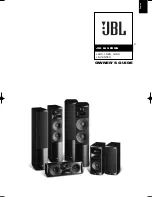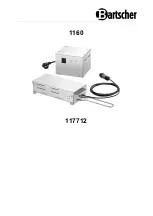
The biwire option also permits powering the system with two ampli-
fiers as shown in Figure 2. Four identical amplifiers (or two dual
channel units) may be used, although specialized low and high
frequency amplifiers can offer clear advantages. Your JBL L-Series
dealer can recommend amplifiers that best suit your needs. In all
cases, the left and right amplifiers for each section must be
identical. Ensure that the input sensitivity of the two amplifiers is
equal or that input level controls are provided to maintain proper
low to mid/high balance. If two identical stereo amplifiers are cho-
sen, each amplifier may be located near a loudspeaker and drive
low frequency and high frequency sections through short wire runs.
Beware that some amplifiers invert the polarity of the signal. Input
polarity should be the same for both low and high frequency
sections. If the polarity is reversed to one section, a discontinuity in
the free-field response will be apparent in the crossover region. Feel
free to experiment with the polarity of the individual section to find a
position that will suit you best. Reverse the polarity to either high or
low frequency sections of both loudspeakers if a problem is
suspected. Amplifier polarity markings may not ensure correct
polarity connections.
AMPLIFIER POWER
RECOMMENDATIONS
The JBL L-Series speakers are capable of handling peak powers far
exceeding the continuous rating specified for the individual
speakers.
The continuous ratings are based on an eight hour test using
broadband noise shaped to simulate the power distribution of
music. The peak rating of approximately 4 times the continuous
rating indicates the system's ability to handle transient peaks well
above the average power'levels.
Amplifier power ratings are an INDICATION of how loud the system
will play without distortion. Amplifier power is generally measured
with steady state test signals and perhaps, in addition, dynamic
measurements into resistive loads. Unfortunately none of these are
firm indications of how loud the system will sound in a given
listening room.
For these reasons, an amplifier should only be chosen after careful
listening. If it is possible to achieve the desired volume level without
distortion, then the amplifier has sufficient power regardless of the
rating.
. More important than the power rating is the quality of sound the
amplifier is capable of. Unfortunately, amplifier specifications are
not a reliable indicator of sound quality. Your JBL dealer can make
recommendations and arrange auditions to aid selection of suitable
amplification.
If the system is set up with separate power amplifiers for high and
low frequency sections, the amplifier for the high frequency section
can be of less power than the amplifier driving the low frequency
section because of the power distribution in recorded music. As an
example: if a 100 watt low frequency amplifier is used, a 50 watt
high frequency amplifier will "run out of power" at approximately the
same level when playing music.
Fuses or circuit breakers of any kind should not be used between
the amplifier and loudspeakers. All such devices will seriously
degrade the sound quality and do not ensure protection from
loudspeaker damage. The key to safe operation is adequate
amplifier power to avoid distortion at the highest sound levels
required.
GENERAL CARE
JBL L-Series loudspeaker systems are finished in materials that will
retain its finish for many years to come. Occasional cleaning with a
clean, soft cloth will maintain the original beauty of the finish.
Only lint-free cotton cloths should be used for dusting. To remove
fingerprints and smudges, an ammonia-free window cleaner may
be used. Apply a small amount to a lint-free cotton cloth and gently
clean the surface. Never use any abrasive cleaners or strong
chemical to clean the enclosure. In case of deep scratches or
damage, please consult a qualified furniture repair shop.
GRILLE
The grille is held in place by a pin located at each corner. To remove
the grille, grasp two corners and gently pull the grille away from the
enclosure. To replace the grille, position the mounting pins on the
cups and gently press until the grille meets the enclosure. Although
the grille has been engineered to minimize acoustical interference,
high frequency response and stereo imaging will be improved by
removing the grille.
Any dust on the grille should be removed using a cleaning brush or
a vacuum cleaner.
SERVICE
JBL L-Series loudspeakers are designed to give years of trouble-free
service. No periodic maintenance is required. If a problem is
suspected, first make sure all connections are properly made. If a
problem exists in one loudspeaker, reverse the speaker wires to the
left and right system. If the problem remains in the same system,
then the fault is in the loudspeaker. If the problem appears in the
opposite system, the cause is in another component or cable.
Loudspeaker cones or diaphragms should not be moved by hand.
The voice coil assembly is located with extreme precision and the
clearance is very small. Any attempt to move the assembly by hand
can easily force the voice coil out of alignment and cause distortion
or failure.
Should your loudspeaker system ever need service, return it to the
JBL dealer from whom it was purchased. If for some reason this is
impractical, write directly to the JBL Customer Service Department,
describing the problem as fully as possible.
Do not return products to the JBL factory without prior
authorization. Address correspondence to: JBL Customer Service,
80 Crossways Park West, Woodbury, NY 11797. Telephone:
1-516-496-3400 or 1-800-645-7292. Outside the United States,
contact your local JBL distributor.
























